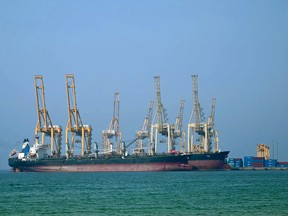
Article content
On Sunday, Iran’s state-owned Press TV media outlet reported that the country’s parliament voted to close the Strait of Hormuz in response to U.S. strikes on its nuclear facilities. The strait is a vital transport route for major Middle East oil and liquified natural gas (LNG) producers. What is the likelihood that Iran will cut off the trade route and what would such a closure mean for global energy supply and oil prices? The Financial Post explains.
THIS CONTENT IS RESERVED FOR SUBSCRIBERS ONLY
Subscribe now to read the latest news in your city and across Canada.
- Exclusive articles from Barbara Shecter, Joe O'Connor, Gabriel Friedman, and others.
- Daily content from Financial Times, the world's leading global business publication.
- Unlimited online access to read articles from Financial Post, National Post and 15 news sites across Canada with one account.
- National Post ePaper, an electronic replica of the print edition to view on any device, share and comment on.
- Daily puzzles, including the New York Times Crossword.
SUBSCRIBE TO UNLOCK MORE ARTICLES
Subscribe now to read the latest news in your city and across Canada.
- Exclusive articles from Barbara Shecter, Joe O'Connor, Gabriel Friedman and others.
- Daily content from Financial Times, the world's leading global business publication.
- Unlimited online access to read articles from Financial Post, National Post and 15 news sites across Canada with one account.
- National Post ePaper, an electronic replica of the print edition to view on any device, share and comment on.
- Daily puzzles, including the New York Times Crossword.
REGISTER / SIGN IN TO UNLOCK MORE ARTICLES
Create an account or sign in to continue with your reading experience.
- Access articles from across Canada with one account.
- Share your thoughts and join the conversation in the comments.
- Enjoy additional articles per month.
- Get email updates from your favourite authors.
THIS ARTICLE IS FREE TO READ REGISTER TO UNLOCK.
Create an account or sign in to continue with your reading experience.
- Access articles from across Canada with one account
- Share your thoughts and join the conversation in the comments
- Enjoy additional articles per month
- Get email updates from your favourite authors
Sign In or Create an Account
or
Article content
Article content
What is the Strait of Hormuz?
Article content
Article content
The Strait of Hormuz is a 167-kilometre-long sea passage that connects the Persian Gulf to the Indian ocean. Bordered by Iran on one side and Oman and the United Arab Emirates on the other, it is a crucial route for shipping crude oil and liquified natural gas from countries such as Iran, Iraq, Kuwait, Bahrain, Qatar, Saudi Arabia and the United Arab Emirates. About 20 per cent of the world’s oil and gas demand flowed through the strait in 2024, according to the U.S. Energy Information Administration (EIA).
Article content
The EIA calls Hormuz “one of the world’s most important oil chokepoints,” as there are few alternatives to move oil from the Gulf states. In a note released on Monday, Capital Economics estimates that no more than 30 per cent of existing oil flows could conceivably be redirected, citing the East-West pipeline in Saudi Arabia, which connects to the Red Sea, and a pipeline in the United Arab Emirates as two potential means of bypassing the Strait of Hormuz.
Article content
Options for Iran are limited, as 96 per cent of the country’s oil exports flow through its main export terminal on Kharg Island, located northwest of the strait, according to commodities and shipping intelligence firm Kpler.
Article content
Article content
Capital Economics points out that Middle Eastern LNG exports, the vast majority of which comes from Qatar, cannot be redirected. “The lack of an alternative for rerouting LNG flows has contributed to the sharp rise in natural gas prices since the start of the conflict,” it said.
Article content
Article content
Where do most of its energy exports go?
Article content
An estimated 84 per cent of crude oil and condensate and 83 per cent of liquefied natural gas that flowed through the Strait of Hormuz in 2024 went to markets in Asia, according to EIA data.
Article content
“China, India, Japan, and South Korea were the top destinations for crude oil moving through the Strait of Hormuz to Asia, accounting for a combined 69 per cent of all Hormuz crude oil and condensate flows in 2024,” said the EIA. “These markets would likely be most affected by supply disruptions at Hormuz.”
Article content
For China, Iran is particularly important. China buys around 90 per cent of Iran’s global oil exports, according to Kpler.
Article content
Capital Economics’ report noted that nearly 50 per cent of China’s crude oil imports come from Iran, giving China “outsized influence” on its ally and “a vested interest in keeping energy trade flowing.”

.jpg) 4 hours ago
1
4 hours ago
1
 English (US)
English (US)